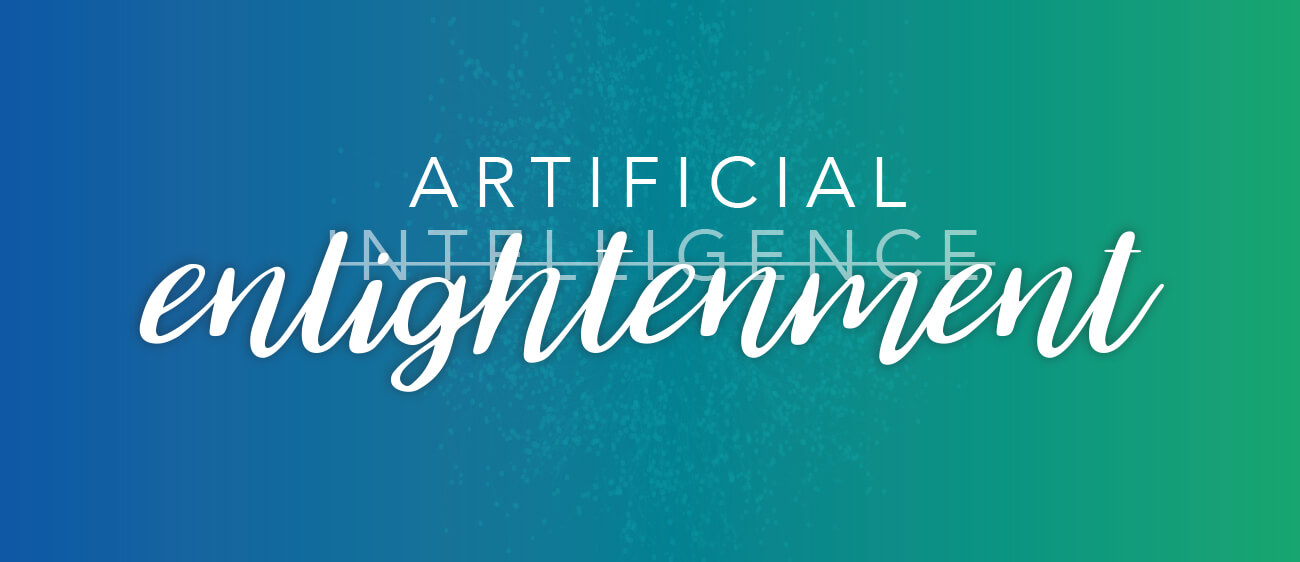Advancing from Artificial Intelligence to Artificial Enlightenment

Throughout history, the human need to cope with complex situations has spurred people to develop tools that ingest and analyze data so that individuals can make better decisions. Mathematics, for example, emerged in Mesopotamia when people needed to count and exchange goods. Millennia later, digital tools such as Excel have built on those fundamentals to make complex data analysis accessible to people and companies worldwide.
Though these tools grow more sophisticated by the day, they still function in a similar way—that is, they deliver insights based on synthesized, aggregated data rather than the particular data points that are relevant to a certain action in a certain place and time. This produces broad-stroke averages that aren’t ideally suited to the real-time, hyper-local operations of the human brain, obscuring critical nuances and limiting the insights’ value for human decision-making.
Artificial intelligence (AI), for example, is good at carrying out narrow tasks when there is an enormous amount of relevant data available and the situation is fairly predictable. It falls short, however, when conditions are changing rapidly and randomly. These cases require a deep, contextual understanding of the situation and all its variables─the type of analysis the human brain was built for. That is why you can teach a seven-year-old child to safely cross the street in a few minutes, but it might take seven years to teach an autonomous car to do it.
As AI continues to develop, another application of the tools underpinning its rise is emerging. The same technological advances that enable AI—including vastly improved compute speeds, parallel processing, the ability to handle massive heterogeneous data sets, and cloud computing—can now be used to deliver the data people need to make better decisions in situ (i.e., locally and in the moment).
Used in this fashion, these capabilities are beginning to give us actionable insights into global challenges such as climate change, public health, food production, supply chain management, and finance. This has the potential to create new opportunities for collaborative innovation to improve our interconnected society and, perhaps, open the door to an era of Artificial Enlightenment (AE).
From Intelligence to Enlightenment
Today’s computational tools and vast quantities of data are making this new paradigm possible.
- Ubiquitous Data: Mobile technology and Internet of Things (IoT) devices are spurring a data explosion, with the World Economic Forum predicting that the digital universe will reach 44 zettabytes of data this year—40 times more bytes than the number of stars in the observable universe. This constant stream of data can increasingly be captured and processed on “edge” devices such as smartphones, enabling more precise decisioning in the moment.
- Next-Gen Processors: Modern processors such as Nvidia’s Graphics Processing Units (GPUs) leverage parallel processing methods to break complex problems into myriad separate tasks and accomplish them simultaneously. This has empowered breakthroughs in deep learning, computer vision, and other AI tools that can be put to use for AE purposes such as real-time recommendations as well.
- The Cloud: Cloud computing enables people and organizations to access and use more compute power, storage, infrastructure software, data, and applications than ever before—in real time. And there is more still to come: Gartner projects that cloud services will grow at nearly three times the rate of the IT services industry through 2022.
The growth in these technologies is enabling new ways to use data for situation-specific insights that address personal, hyper-local challenges with precision.
Here are a few examples that hint at what can be achieved if we focus more time and energy on unleashing AE.
Local Solutions to Global Problems
The Earth is warming, but average global data such as “1 degree centrigrade warmer” tells us little about how to target problems on the ground, where to divert resources, or how to manage logistics. That disconnect often lulls people into inaction.
Enabled by today’s technologies, however, we can go deeper to collect and process more data in real time—and save lives. In 2018, for example, monsoon rains consistent with climate change predictions produced the worst flooding in the south Indian state of Kerala in the last century. The floods killed more than 400 people and displaced over a million.
At the time, a company called SatSure─with operations in India, Australia, and Europe─was using geospatial data from space-based sensors to optimize crop production and guide engineering projects. In response to the storm, SatSure used flood and rainfall data along with government mapping tools to predict flooding at the street level. This helped identify areas under imminent threat and enabled local officials to prioritize their emergency responses, leading to the rescue of more than 80 stranded residents and the evacuation of thousands.
Saving Time and Money
Shipping goods around the globe is complex, costly, and mission-critical for multinational companies. Losing just an hour in transport can increase costs by nearly $80,000, and often critical delays happen in the port, when ships are literally navigating the last mile.
The Port of Rotterdam traditionally relied on radio and radar communication between captains, pilots, terminal operators, tugboats, and others to inform key decisions on port operations. In 2018, however, it deployed a centralized dashboard application that collects real-time water, weather, sensor, and communications data and processes it through an IoT platform to provide detailed, continuously updated information.
This information can shave precious and costly minutes off the wait times for the hundreds of thousands of ships that enter the port each year, saving businesses billions of dollars annually.
Artificial Enlightenment at Citi
At Citi we are building and working with new tools that leverage AE to address emerging technological and societal needs. These include:
- Career Advancement: When you buy a home, you can compare properties, neighborhoods, and mortgage rates from a wide variety of sources. But what about job hunting? People searching for a way to advance professionally have traditionally had to navigate an opaque market largely on their own. As the working world evolves from linear careers to a patchwork of opportunities, Citi Ventures Studio has developed Worthi by Citi, a data-driven tool that hyper-personalizes the job-seeking experience for individuals, providing the right data and information people need to make smart decisions about how to advance based on their needs and preferences.
- Place-Based Investing: Investors in economically distressed communities such as U.S. Opportunity Zones face a huge analytical challenge. How can they determine where their money will do the most good and deliver the greatest ROI? Citi Ventures Studio recently launched City BuilderSM by Citi, a free platform that integrates and analyzes information on Opportunity Zones in 50 U.S. cities to assess each community’s need for jobs, affordable housing, access to food, and other vital services. By providing greater access to precise, targeted information, City Builder is working to help investors, developers, municipalities, and community members collaborate and make more impactful investments where capital is needed most.
- Machine-to-Machine Communication: Even cars are benefitting from new tools and data, which are helping them get smarter and think more like humans. Citi Ventures has invested in Car IQ, a startup that is developing a "digital vehicle fingerprint" based on sensor data, which allows cars to validate themselves and securely transact with service providers. This foundational technology can help cars play a more active role in their own maintenance, not only alerting drivers to when they need an oil change but scheduling and paying for the change themselves.
CONCLUSION
Opportunities to use computational tools not just to mimic human intelligence through AI, but to leverage it through AE, abound all over the world—across industries and disciplines, in the public and private sectors, and in organizations large and small. As the COVID-19 crisis illuminates the challenges of relying on aggregate data to drive individual changes in behavior, there may be no better time to start working toward a world of artificial enlightenment.
